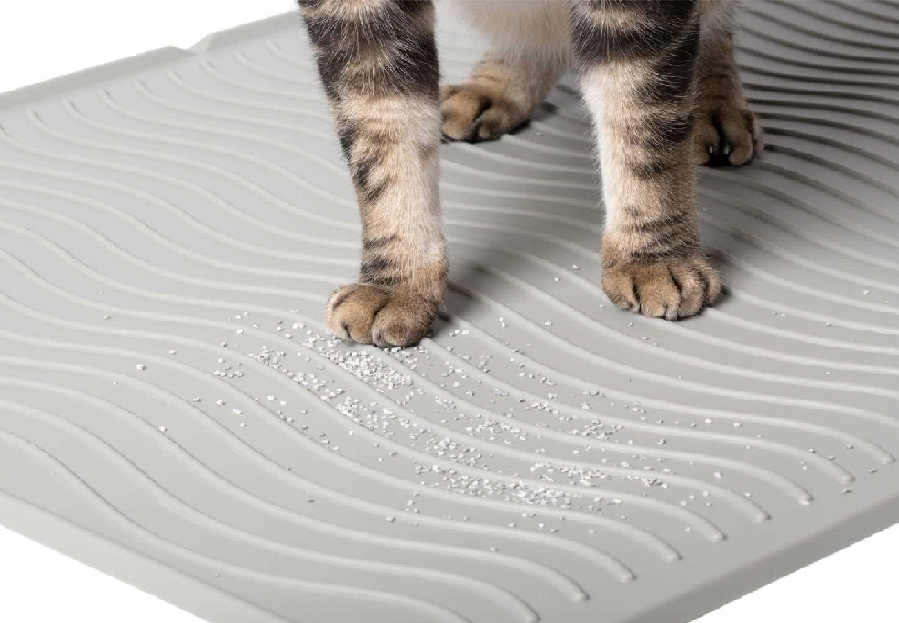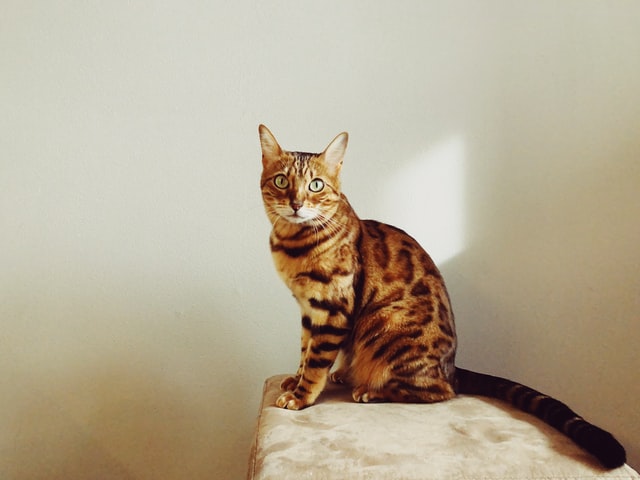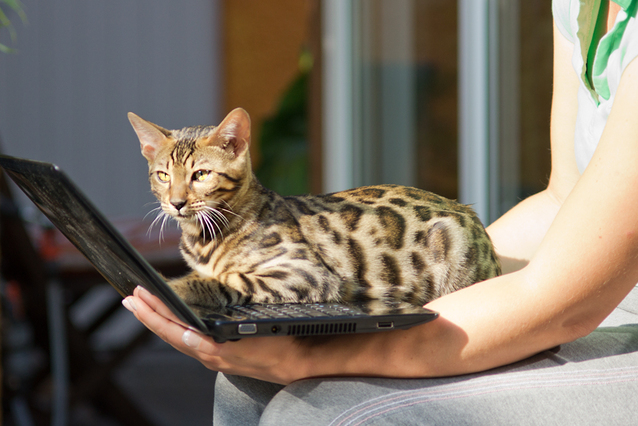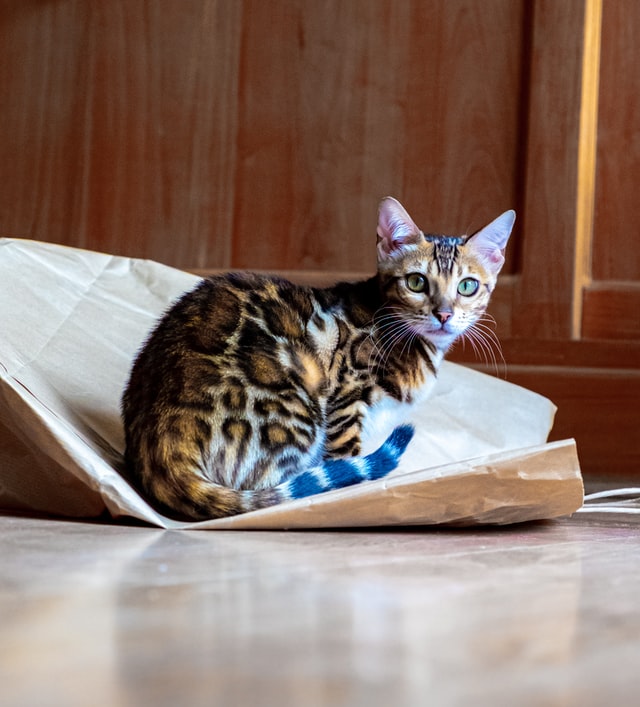
With so many options out there, it can be difficult to know exactly what Bengal cat litter box, or boxes, to buy.
Especially for first time owners with a soon to be acquired Bengal kitten.
An open tray, hooded, partially enclosed, automatic, top entry, sifting- the list of possibilities is long.
And that’s without considering size, shape or how easy each is to clean.
This article covers the main players in the cat litter box world, how they differ, the pros and cons of each and how they may suit particular cat requirements.
I’ll also tell you what we use for our Bengal Hazel.
Do Bengal Cats Use Litter Boxes?
Yes.
There will be specific requirements to consider, as there are for every cat and which we will go into, but Bengals will happily use a litter tray or trays, if they meet their needs.
Put simply, their basic wants are for something that is large, clean and easily accessible.
What Is The Best Cat Litter Box?
As cats have different preferences (and there will be your own to consider also), with regards to say size for example, it’s hard to recommend a specific type.
That’s why I’ll stick to describing each and point you in the right direction should a particular style be the right fit for you and your Bengal.
So let’s look at what you need to know first…
Factors To Consider When Choosing A Bengal Cat Litter Box
There are a few- some relate to your cat, others to you, or both.
Litter Box Size
Size is everything as far as Bengal cat litter boxes go- the bigger the better. That’s because Bengals tend to fall into the larger end of the cat size spectrum.
You may find that standard boxes sold for cats simply don’t cut it and that large storage boxes are actually a better alternative.
Of course, it’s not possible for everyone to buy big as you may simply not have the space.
It’s also worth noting that older Bengal cats need boxes with lower sides as these are easier to enter and exit.
In all cases, ensure your box is large enough for your cat to turn around in, and deep enough for a good couple of inches of litter.
Entry- How Your Cat Accesses The Box
I also thought it was simply a matter of side entry from the lowest point, but top entry boxes are an alternative.
Shape
Most are rectangular with curved edges as you might expect, but some are designed for corners, so may be more suitable for those living in smaller apartments.
How Easy It Is To Clean
Not the most enjoyable task in the world, which is why a box that’s easy to clean will be sought after by most.
This has repercussions for your cat as a cleaner tray is likely to be more attractive to your Bengal.
Odour Control
In all honesty, I can’t imagine ANYTHING will completely stop that level of bad odour getting into the air, but some claim to be able to help the problem, specifically self-cleaning boxes or those that separate waste.
Lidded, Open or Hybrid
Open trays are most common, but boxes with lids and swing doors are also abundant.
Some cats prefer ‘privacy’; others are wary of enclosed spaces when excreting due to the fear of predation or being attacked. There are also some concerns that the build of waste gases can put off some cats, but lids often have vents to alleviate this.
For owners, lids offer the advantage of not having to look at any solids until cleaning time, a reduction in litter scatter (a mat will also help see ‘The Best Cat Litter Mats [2021]‘), and some, perhaps limited, odour control.
Trays that are partially enclosed are a third, halfway-house option.
The Number of Boxes
Quite straightforward- how many do you need?
The general consensus is two per cat, and one per floor, especially with Bengal kittens.
Of course, more boxes mean more expenditure, more space and more cleaning.
Positioning
Boxes should be placed in areas where cats spend much of their time, but away from their sleeping and feeding areas.
I’m sure you will have preferential spots or restrictions on where they can go in your home, so positioning may impact on the size, shape and number of boxes you can have.
Price
Basic trays and boxes can be picked up for a few pounds/dollars. The most expensive self-cleaning automatic trays can cost in the hundreds.
There are also on-going costs to consider with trays that use urine absorbing pads alongside litter or crystals (that basically work the same way as litter).
Your Bengal’s Behaviour and Preferences
This is key.
No matter what you prefer, if your Bengal has box issues, it’s not going to use it.
This may involve some trial and error initially, but it’s always a good bet to where possible, continue using the same type of box as used by your breeder.
This way your Bengal kitten/cat maintains some kind of familiarity- and it’s a box you know that works.
What Is Suitable Material For A Cat Litter Box?
You will find most are constructed from plastic, although there will be metal components to some of the more high-tech trays.
In fact, you can buy metal/stainless steel open trays too- like this one.
Essentially, in terms of materials, you’re looking for something hard wearing that won’t leak or absorb moisture, and ideally, is easy to clean.
Non-toxic materials are also clearly, a good idea.
The Bengal Cat Litter Box List
#1: Open Cat Litter Box
These are the most common and come in a variety of sizes, heights and colours.
You’ll find these in most pet stores and supermarkets, although you don’t need a designated litter pan per se- just something that equates to one, like a large plastic storage box.
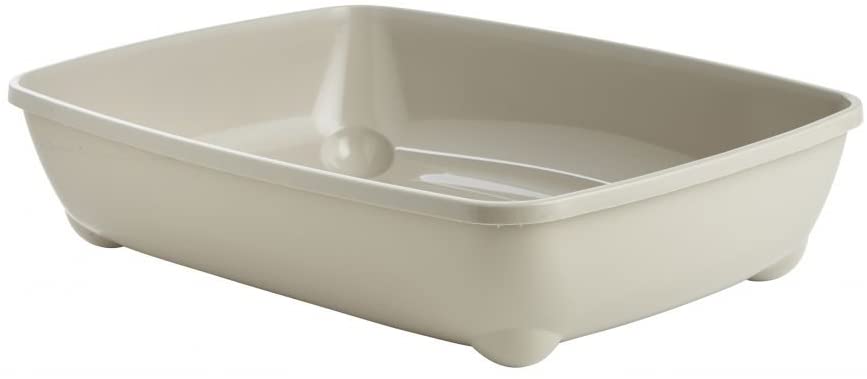
Pros:
Widely available
Should easily find a size that fits yours/your cat’s needs
Generally the cheapest type
As everything is on show, it’ll trigger you to clean the box more often
Cons:
Litter (or worse) can be more easily kicked out of the box
Faeces is exposed and visible
Odours are not contained- although as I mentioned, I’m not sure any box really contains odours
Features to Consider:
Size- make sure it is big enough for your cat and fits in the desired location
Shape- most are rectangular but some now are designed to go into corners, like the one below:
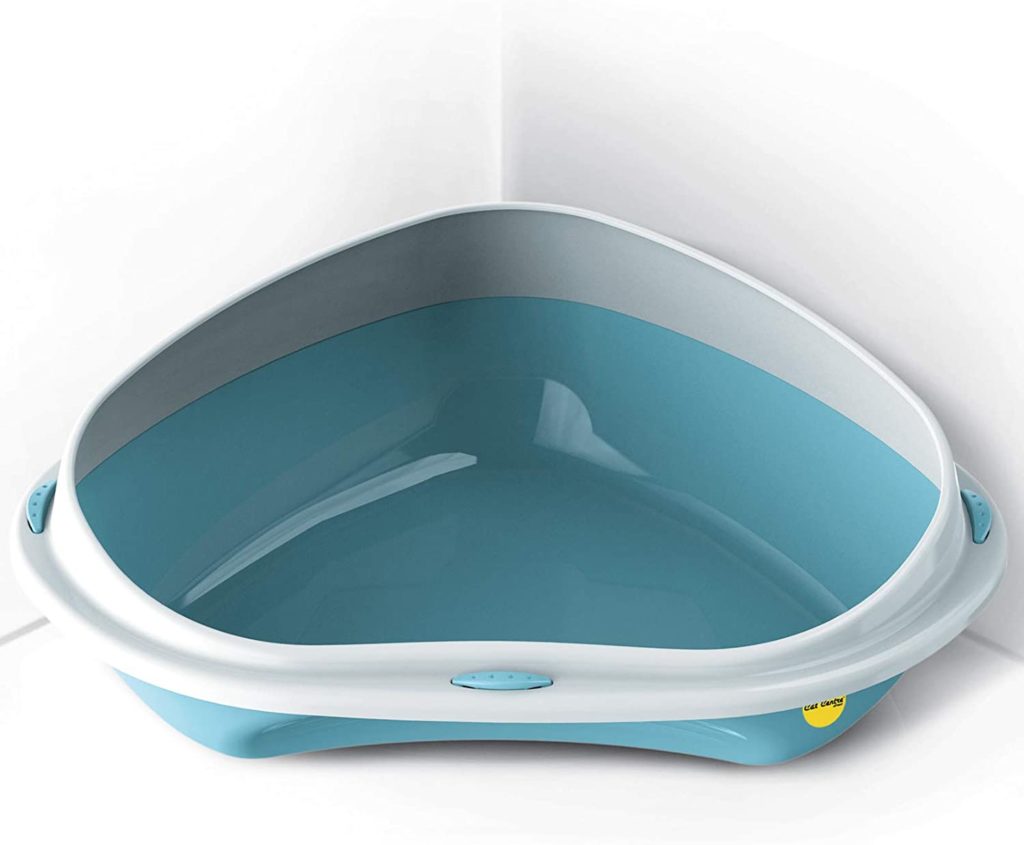
Materials- non-toxic, and something easy to wipe clean.
Low entry boxes and those with lower sides are better for older cats or those with health issues, but expect more contents to escape.
High sided boxes are a good choice if your Bengal is a bit of a digger, as they will reduce litter scatter.
Check Prices and Reviews of Open Boxes on:
#2: Lidded or Enclosed Cat Litter Boxes
The next step-up from open trays.
Lids are removable to make cleaning easy and can be added later if cats that have only previously used open trays need an introduction to the lidded kind.
Usually a little more expensive than open trays, but not prohibitively so (although I guess that depends on your own financial situation…)
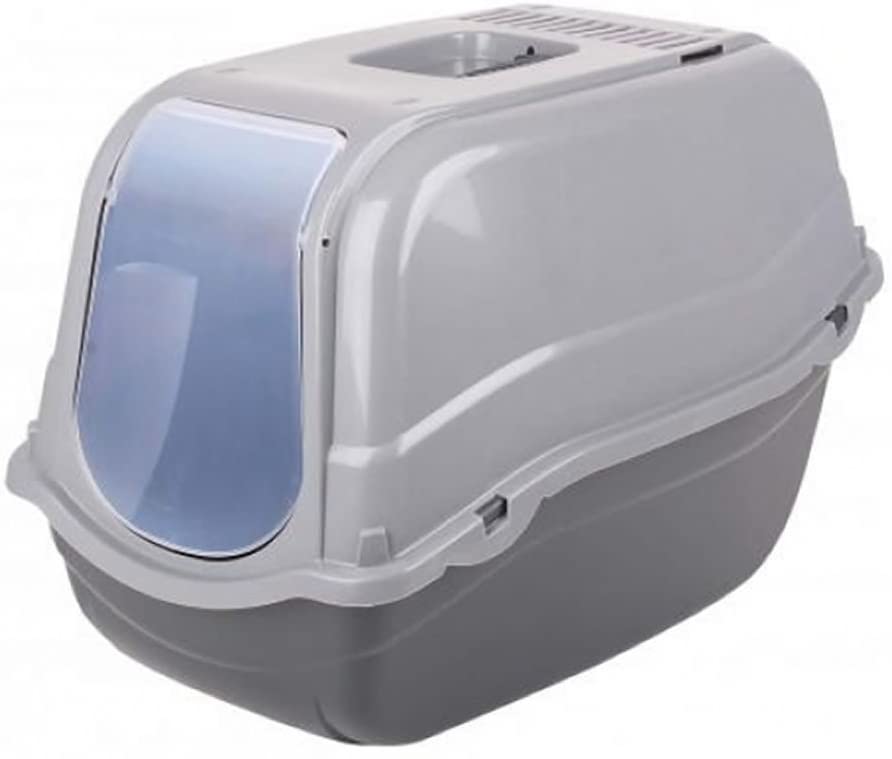
Pros:
Less litter or waste is likely to escape the tray
Offers privacy to cats who prefer to do their business away from ‘prying eyes’
Perhaps some sort of odour control (again, doubtful…)
Cats waste is not visible
Cons:
Not being able to see the waste may lead to ‘out of sight, out of mind’ behaviour and the tray being cleaned less than it needs to be
Some cats may need initial further training, that is, be shown how to get in and out
For cats used to open trays, lids sometimes need to introduced
Bengals being bigger may not have sufficient space, or indeed, may not like an enclosed environment to go in
Features/Things to Consider:
Size- again the bigger the better if possible
A lid that detaches easily for cleaning purposes
Low entry points for older cats/those with health problems
As these box types only have one entry/exit point, ensure you can place it somewhere where it is unlikely to get blocked. You can guess what is likely to happen if it does (and that’s coming from personal experience…)
Check Prices and Reviews of Lidded Boxes on:
#3: Partially Enclosed Cat Litter Boxes
These offer a compromise between fully open and lidded, which is both good and bad…
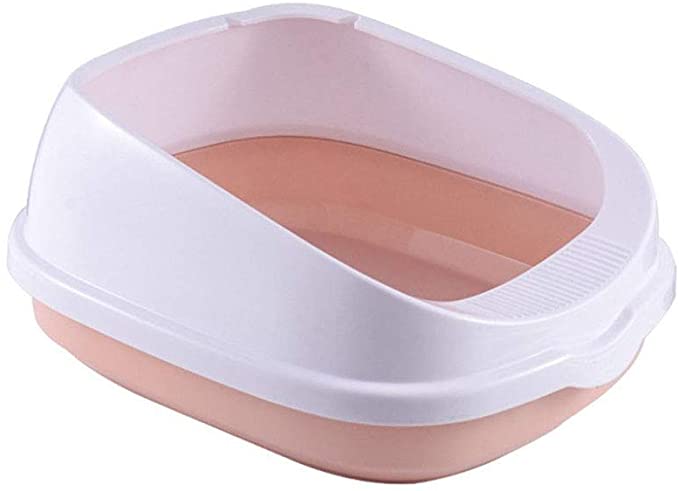
Pros:
Concave or rimmed sides offer some privacy
Better than more open boxes at preventing the scatter of litter
Cons:
Limited to non-existent odour control
May still be too confined for larger cats
Features/things to look out for:
Size
High entrances with these boxes may be beneficial if your Bengal urinates towards the edge (as ours tends to), but again not ideal for older individuals
Some have detachable rims to make cleaning easier
Check Prices and Reviews of Partially Enclosed Boxes on:
#4: Top Entry Cat Litter Boxes
Put simply, these are containers with a hole cut into the top of a detachable lid.
Looking more like waste paper bins than cat litter trays, top entry boxes are more discreet, but this ability to ‘fit in’ with your home means you’ll have to pay that bit more…
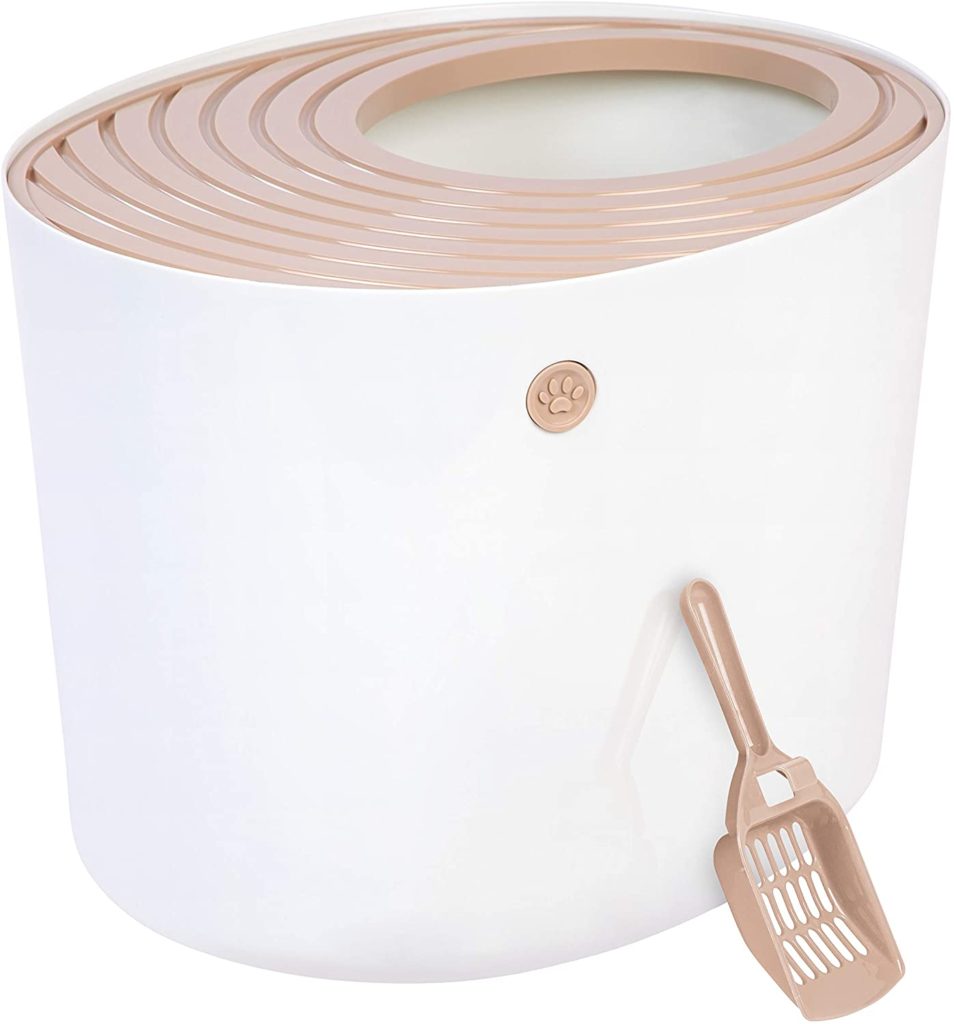
Pros:
Generally considered to prevent litter from tracking onto flooring
Complete privacy for cats that prefer it
Cat waste is not on display
Cons:
Harder to use for older cats, smaller Bengal kittens, or those cats with physical health problems
If your cat is used to a side entry or open box, they made need retraining, or may not use it at all
Not being able to see waste may lead to ‘out of sight, out of mind’ behaviour and the boxes being cleaned less than it needs to be
Generally more expensive than traditional boxes
Bengals being bigger may not have sufficient space, or indeed, may not like an enclosed environment to go in
Features to consider:
Size- you’ve guessed it, the bigger the better, but also consider it being at at height that’s simple for you cat to get on and off
Some top entry boxes also have a side entry flap and/or a removal tray at the base like the one below:
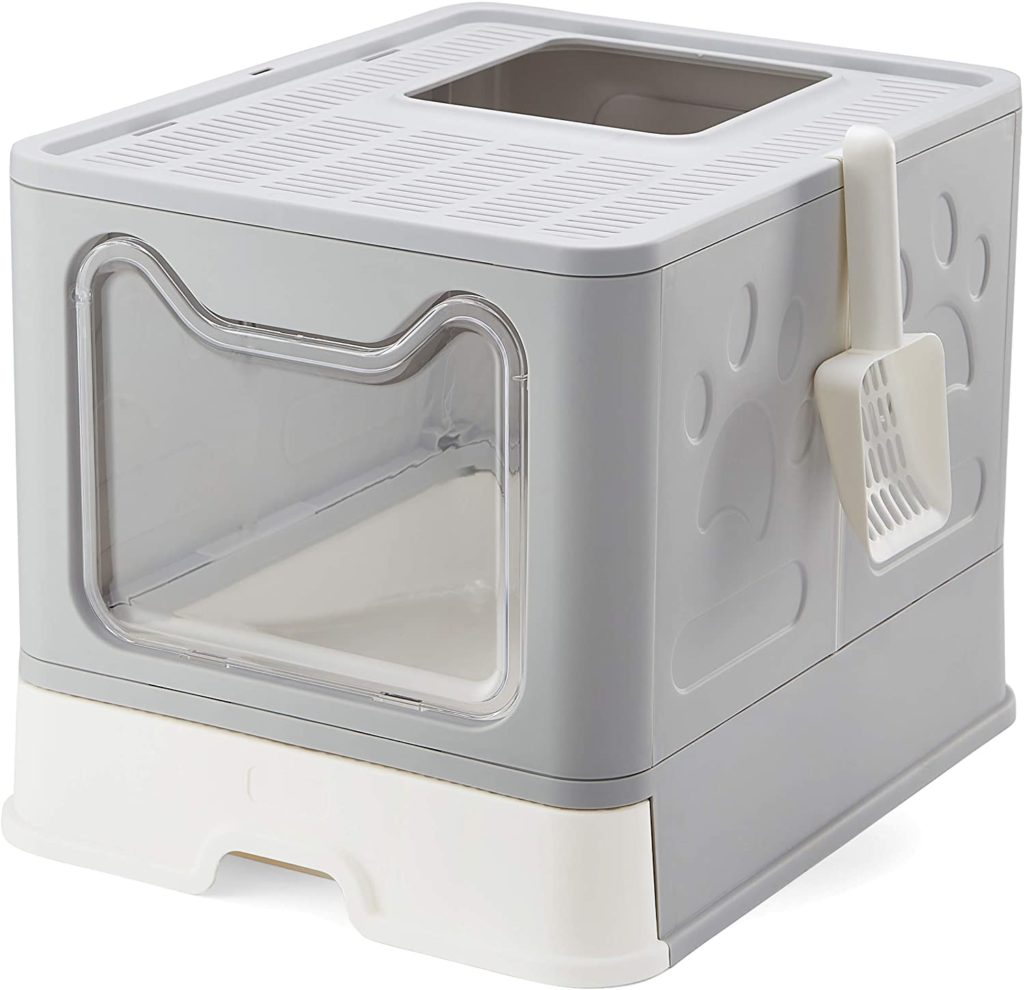
This though may defeat the purpose of having a top entry box to start with…
Check Prices and Reviews of Top Entry Boxes on:
#5: Sifting Cat Litter Boxes
For those who don’t like to scoop their cat’s poop (which is a line they could have used in the advertising) come sifting litter trays.
These are open litter pans with an additional grill tray.
Imagine ‘panning for poop’ (another phrase they can have…). This sits on the grill whilst the litter falls through into the main tray.
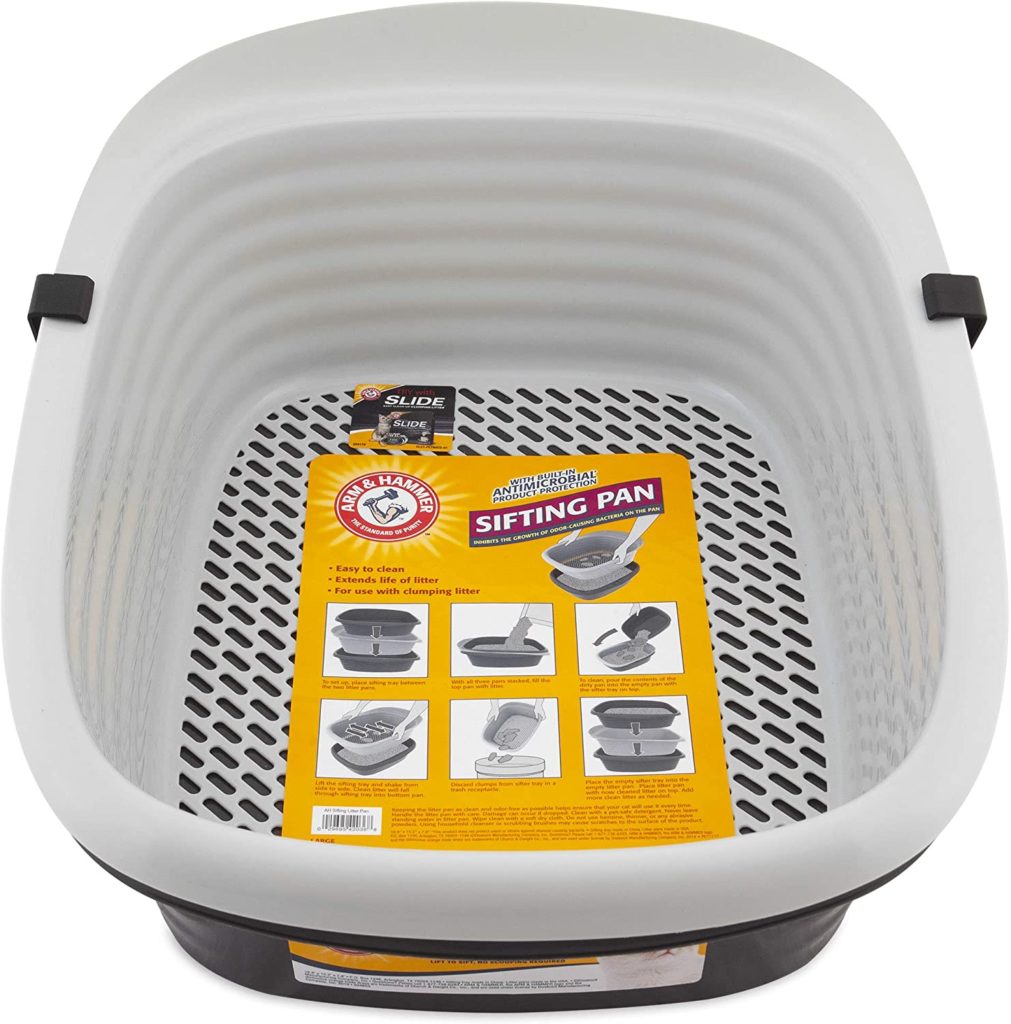
Pros:
Sifting litter instead of scooping should make it easier to get rid of large, solid waste deposits
As this is essentially an open litter pan, with an additional ‘sifting’ function, the pros of open boxes apply here too
Cons:
Small clumps of faecal waste will still get through the grill
Cleaning the grill itself of any sticky waste or litter could be trickier
Urine which gets soaked up by litter which then powders (for example woodchip) will fall through the grill
See additional points from the cons list under ‘Open Boxes’
Features/things to consider:
See those under Open Boxes, plus…
Size of the holes in the sifting grill- especially when considering the litter you use
Ask yourself whether this type of box dovetails well with the type of litter you use. Clumping may be the best cat litter for this particular tray, for example
Check Prices and Reviews of Sifting Boxes on:
#6: Automatic Self- Cleaning Litter Boxes
Even Bengal cat litter boxes can’t escape the clutches of technology.
Who would have guessed (although many may have wanted) automation (or semi-automation) would one day be employed to rake cat faeces?
Actually, not all use a rake system, and some are completely litter free.
Most are covered/lidded and look as if they’ve been designed for inter-galactic travel but some more closely resemble open boxes.
Automatic self-cleaning litter boxes then are there to make life easier by removing waste material from the tray so you don’t have to (as much), although there are question marks with regards to how effective they actually are…

Pros:
In theory, eliminate the daily need to ‘scoop’ out the box
Better odour control
Many offer at least a 1 year warranty
Cons:
Very expensive compared to trays that don’t self clean
Most require the use of clumping litter which your Bengal may not be familiar with
The boxes themselves still need cleaning, which with all the extra components, will be a less straightforward job
Rakes are prone to getting clogged and do not always remove all waste
Many aren’t suited to cats with loose stool or diarrhoea
Features/things to look out for:
Size
Consider all the pros and cons of open types versus hooded or lidded
Some have weight restrictions which fall at the upper end of the Bengal weight range
The method of removing waste- most use a rake, others like the one below, rotate and deposit waste in a separate compartment.
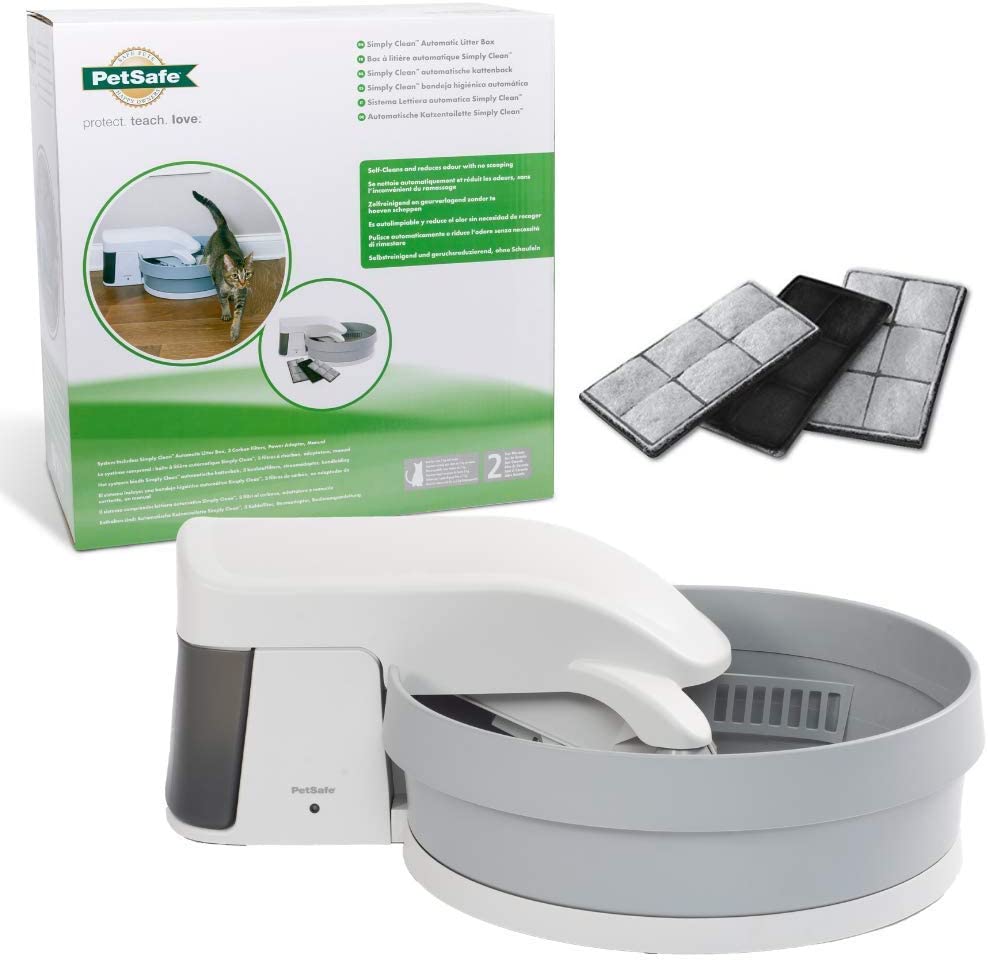
Weigh up the cost/benefit ratio
Some potential for noise
Check Prices and Reviews of Automatic Self-Cleaning Boxes on:
#7: Boxes That Separate Waste
The idea behind these boxes is that urine and faeces are separated, theoretically making cleaning more straightforward and controlling odours.
This system requires the use of pellets or crystals as a top layer, with an absorbent pad in a tray underneath.
Solid waste sits in the pellets and crystal, with the liquid percolating through to the pad.
Boxes of this nature may be ‘hooded’ or open.
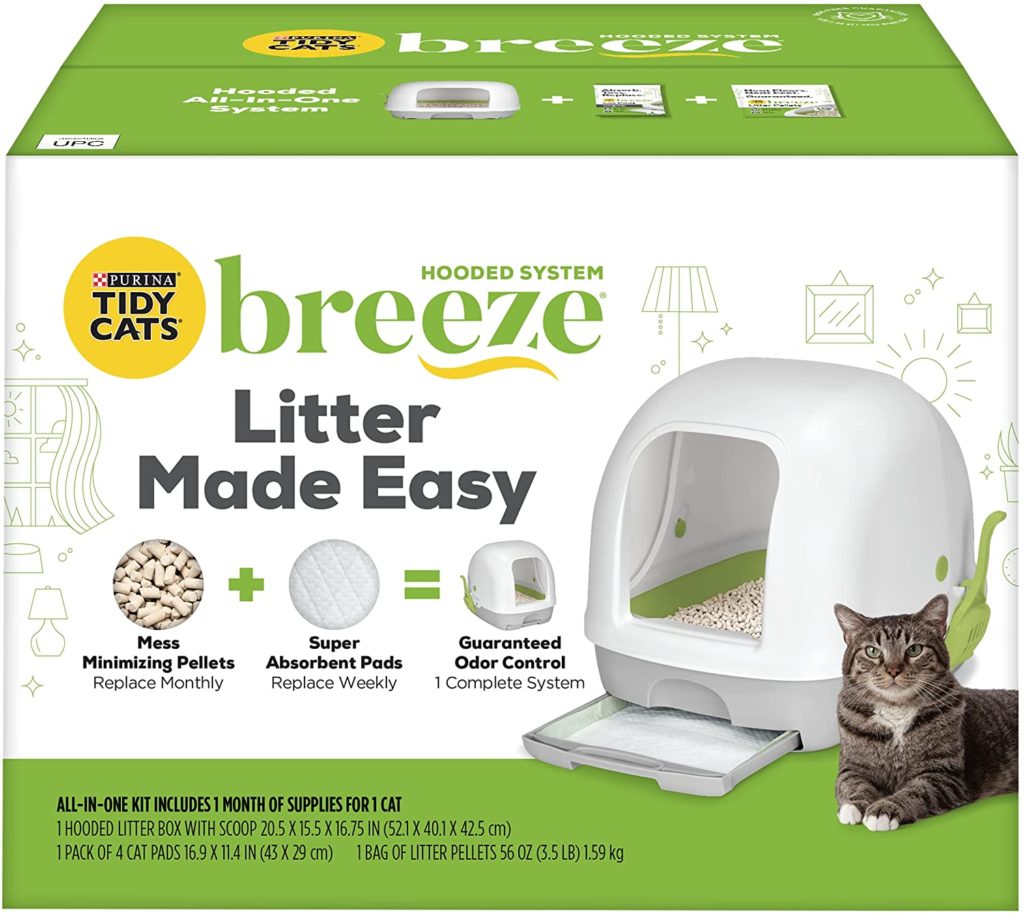
Pros:
Convenient and time saving
A potential reduction in smell
Less tracking of litter/crystals around the home
Cons:
Initial cost can be quite high, plus the on-going cost of pads and special litter or crystals
Still a need to scoop out the tray
Pellets or crystals may not suit your cat (or their feet)
Features/things to consider:
Size
Whether an open or hooded box is preferential (and the pros and cons of each)
Retraining your Bengal to use the pellets/crystals
On-going costs
The system may not be able to cope in multi-cat households
Check Prices and Reviews of Boxes that Separate Waste on:
Do Bengal Cats Pee Outside the Litter Box?
They can do, as can all cats.
Potential reasons for litter box issues are plentiful, but first it’s establishing whether your Bengal not using a cat litter box for toilet/latrine behaviour or if it’ actually spraying.
For problems with Bengal cats that spray, see the article ‘7 Big Reasons Why Your Bengal Cat Is Spraying [and how to stop it]‘.
What Bengal Cat Litter Box De We Use And Why?
We have two lidded trays.
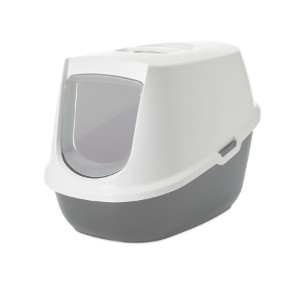
The reasons being we didn’t want to see her waste, we hoped there would be some element of odour containment, and litter scatter would be minimal.
In the main, factors 1 and 3 proved to be true (although we did also buy a litter mat), but as mentioned, we could still smell everything pretty strongly..
Hazel used these without problems for months, then suddenly started urinating outside her boxes- I’ll cover this and what we did/tried to do to remedy the situation in a future blog post.
We added an additional open tray, so now have three- one upstairs and two downstairs.
There have been no more (major) problems, but again, you’ll have to wait for the blog post to see where we are with this and why we think the issue has been pretty much resolved….
Summary
No-one can really recommend ‘the best’ Bengal cat litter box, although with regards to size, for example, Bengal cats need those that are on the large side.
This list is a great starting point for those looking for their first Bengal cat litter box, and I hope, has given you plenty to think about and work with- and will help you avoid any possible Bengal cat litter box problems.

As with many products, it’s about knowing your cat and its preferences, which is harder to establish if buying a kitten.
It’s a good idea to follow on from what the kitten is used to and seek advice from your breeder.
Remember, much of what is sold is for the benefit of humans as opposed to cats, especially automatic, self-cleaning trays.
If you’re still not sure which box to purchase, maybe you can train your Bengal cat to use the toilet… yes, it is possible…
Further Reading:
Please note, Amazon links on this page are affiliate links from which I’ll receive a small percentage if you purchase at no extra cost to you. It all helps. Thanks.

